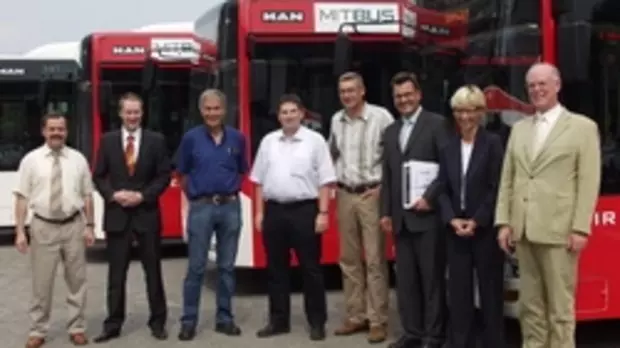
MIT.BUS GmbH, the subsidiary of Stadtwerke Gießen AG (SWG), is converting part of its fleet to natural gas buses. Five new low-floor articulated buses with natural gas drive are taking to the streets of Giessen. Yesterday, Mathias Carl, Managing Director of MIT.BUS, together with Manfred Siekmann, Chairman of the SWG Management Board, and his fellow board member Reinhard Paul, presented the new purchases totalling 2 million euros. The new MAN Lion's City G buses with CNG drive (Compressed Natural Gas) will operate in the Giessen city bus sector. "Due to its outstanding environmental compatibility, natural gas is a suitable fuel for vehicle use, especially for city bus routes. We want to take an important step towards protecting the environment and are therefore focussing on natural gas buses," explained Mathias Carl.
Buses fuelled with natural gas at SWG
In contrast to many natural gas cars, natural gas-powered buses do not have a petrol tank, so they are monovalent and only have natural gas in the tank. This does not have a negative impact on normal scheduled services, provided that a suitable refuelling station is available. SWG has invested around 680 thousand euros in a natural gas filling station on its premises in Lahnstraße to supply the future bus fleet with this environmentally friendly and affordable fuel. This was because the compressors at the natural gas pump at the Aral petrol station in Marburger Strasse could not meet the demand of the buses. For this reason, there was no way around a refuelling system suitable for buses and trucks. However, to ensure that the fuel pump receives sufficient supplies, SWG laid a 900 metre long high-pressure pipeline from the West transfer station in Schlachthofstraße to its premises.
Environmentally friendly drive
Vehicle emissions are also a burden on the environment in Giessen. Natural gas vehicles are an alternative for reducing vehicle-related emissions. The natural gas buses are an investment in the future, as their exhaust emission values are already below the strict EURO 5 standard, which will come into force in 2008 at the latest, and therefore already fulfil the most demanding current exhaust emission standard EEV (Enhanced Environmentally Friendly Vehicle). The natural gas buses are not only clean for the environment, they are also quieter and more economical. The five CNG models are to be followed in the next few years by further natural gas-powered buses.
Fewer pollutants - cleaner air
By using CNG buses, MIT.BUS is making an active contribution to reducing pollutants. With a mileage of 600 thousand kilometres per bus, the emission of nitrogen oxides (NOx) is reduced by over 3,300 kilograms (kg) with a natural gas bus compared to a Euro-3 diesel model. Emissions of carbon monoxide (CO) and hydrocarbons (THC) are also lower in natural gas buses than in diesel-powered models: Carbon monoxide savings 510 kg and hydrocarbon savings 90 kg. The natural gas buses also emit 88 kg less particulate matter (PM) than a diesel vehicle.
The comparison at a glance
NOxCOTHCTHCCDiesel | ||||
Euro | 34560 kg780 | kg240 | kg90 | kgNatural gas |
EEV1200 | kg270 | kg150 | kg90 | |
kgDifference3360 | ||||
kg510 | kg90 | kg88 | .8 kg<></></tbody> |
This means that 16,800 kg less nitrogen oxides, 2,550 kg less carbon monoxide, 450 kg less hydrocarbons and 444 kg less particulates will be blown into the air in Giessen in future.
Equipment and technology
The new buses with an overall length of 18 metres are powered by a water-cooled rear underfloor four-stroke petrol engine with central gas injection with 310 hp, which delivers 2,000 newton metres of torque. They are equipped with a regulated 3-way catalytic converter. The buses have a tank capacity of 1,330 litres thanks to a roof tank system with seven carbon cylinders, each holding 190 litres.
Easy boarding
With this acquisition, all but one of the vehicles in the MIT.BUS fleet are equipped with low-floor technology. The lower vehicle floor makes boarding and alighting much easier - this is often a problem with conventional buses, especially for parents with pushchairs, wheelchair users or people with walking difficulties. Double-leaf interior swing doors and the side "kneeling" with a lowered floor also make it easier to get on and off. Bus drivers can also look forward to a more comfortable workplace. The new bus fleet has air conditioning and ensures a pleasant climate throughout the driver and passenger compartments. The driver's workplace fulfils the standards of the Association of German Transport Companies (VDV).
Urban mobility of tomorrow
The only difference between MAN's natural gas buses and diesel-powered vehicles is the aerodynamic bonnet on the roof. This is where the storage system is located. The natural gas is stored at an operating pressure of 200 bar. The MAN low-floor buses not only stand for pioneering passenger transport, but also for unmistakable design. This also applies to the advanced technology and maximum comfort for passengers and drivers.

